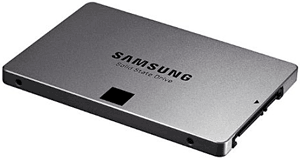 A while back I purchased a 120Gb Samsung 840 EVO solid state drive (SSD) for my desktop PC, and I love it.
A while back I purchased a 120Gb Samsung 840 EVO solid state drive (SSD) for my desktop PC, and I love it.
At first this drive was lightning fast, but before long I noticed that it had slowed down to the point where it was really no faster than a traditional spinning hard drive.
I double-checked all the settings and made sure there was plenty of free work space available on the drive, and nothing seemed to be amiss. Frustrated, I did a Google search to see if anyone else was having problems with their Samsung SSDs, and sure enough, they were.
Apparently Samsung had discovered that there is a performance bug afflicting many 840 EVO SSDs, and mine was one of them. Luckily, the fix turned out to be relatively quick and painless.
All I had to do was visit this page on the Samsung website and download a free tool that fixed the bug quite easily. It’s called Samsung SSD 840 EVO Performance Restoration Software, and you can download it by clicking the Samsung Performance Restoration link on that page.
Using the utility is easy. Simply click on the download link, download the file, then run it. You’ll be presented with a list of all the Samsung 840 EVO solid state drives that are present on your system. In most cases, there will only be one. Select the drive you wish to “fix” from the drop-down list. You’ll be advised to back up your data before proceeding (and I think that’s very good advice).
Important: Make absolutely certain that you don’t turn off the PC or lose power to the computer during the Performance Restoration process. If you do, the drive will most likely be scrambled and your data will be lost.
If you have a desktop PC, it is strongly recommended that you plug it into a battery backup unit before starting this procedure.
The first step in the Performance Restoration process involves checking to see if there is a firmware update available for the SSD. There almost certainly will be unless you have already downloaded and installed the latest update.
If the software determines that there is indeed a firmware update available, it will automatically download and install it. After the drive’s firmware has been updated, the utility will immediately begin the Performance Restoration process. Just let it do its thing until it is finished.
After the Performance Restoration process has been completed on your SSD, you can repeat the procedure for any other SSDs that might be connected to your PC. After the last drive has been “fixed”, you should notice a dramatic improvement in your SSD’s read speeds.
By the way, the Samsung 840 EVO line of SSDs are excellent drives and an outstanding value for the money. Click here to read my review of the 120 GB model.